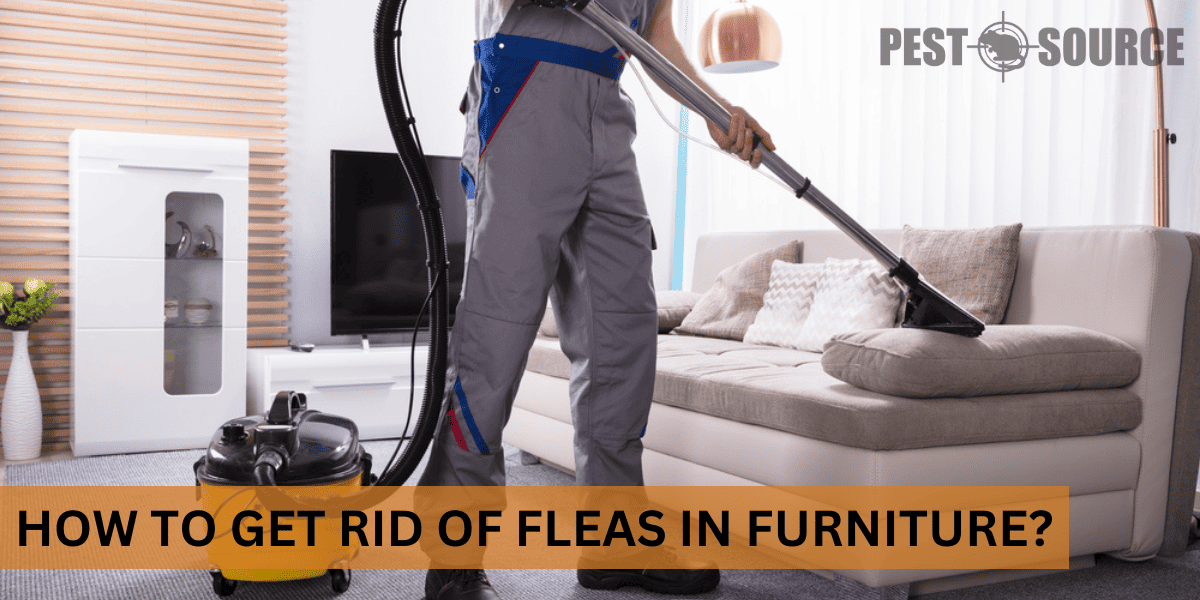Fleas are more than just an itchy nuisance; these tiny pests can infest your home, particularly your furniture, causing various problems for you and your pets. Learning how to effectively get rid of fleas in furniture is crucial in maintaining a comfortable and healthy living environment.
This comprehensive guide will discuss the reality of fleas on furniture, understanding the problem, and provide practical tips for identifying, treating, and preventing flea infestations in your home. With our expert advice, you’ll be well-equipped to tackle these unwelcome guests and restore peace and comfort to your household.
POINTS
- Identify and treat fleas on your furniture: Inspect furniture for signs of fleas and their eggs, and use flea sprays, powders, or aerosols specifically designed for furniture to treat infestations.
- Regularly clean and maintain your home: Vacuum your furniture, floors, and pet bedding frequently, and wash removable cushion covers and pet bedding in hot water.
- Take care of your pets: Groom them regularly, and use veterinarian-recommended flea treatments to keep them free of fleas.
- Use alternative flea treatments and home remedies: Steam cleaning, food-grade diatomaceous earth, and dish soap traps can help to eliminate fleas from your furniture without relying solely on chemical treatments.
- Prevent flea re-infestations: Implement a consistent flea prevention plan for your pets, maintain a clean home environment, and apply preventive flea treatments as needed to your furniture.
The Reality of Fleas on Furniture
What attracts fleas to furniture?

Fleas are attracted to furniture primarily because it provides them with a warm and comfortable environment to live and reproduce. Furniture, especially upholstered items like sofas and armchairs, provides ample hiding spots and access to blood meals from humans and pets. The presence of pet hair, dander, and crumbs from food also attract fleas to settle in furniture.
How common is it for fleas to infest furniture?
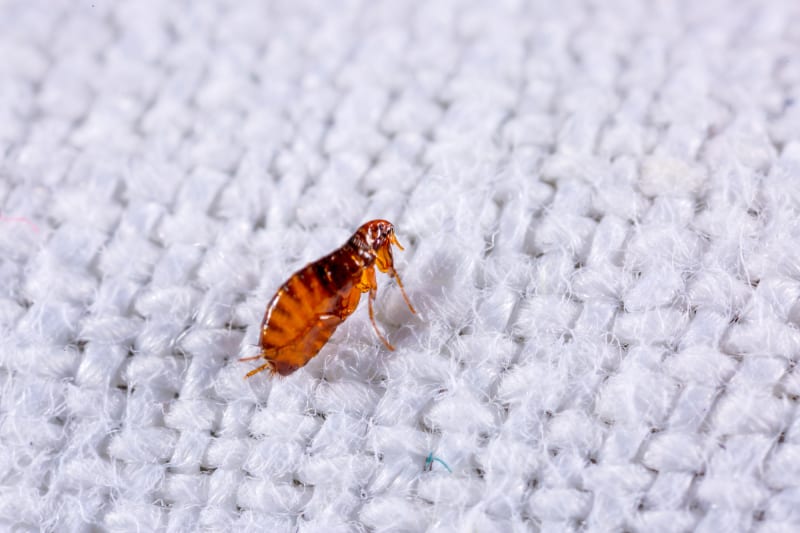
Flea infestations in furniture are quite common, especially in homes with pets. Fleas can easily hitch a ride on pets and people, making their way to your home and settling in your furniture. Once established, they can reproduce quickly, leading to a significant infestation in a short amount of time.
Can fleas live in furniture or couches? For how long?
Yes, fleas can live in furniture and couches. Adult fleas can survive up to 100 days without a blood meal, while flea larvae can live for several weeks. Furniture provides a suitable environment for these pests to complete their life cycle, which consists of eggs, larvae, pupae, and adult fleas. If left undisturbed, fleas can continue to flourish in furniture for an extended period.

How can the presence of fleas in furniture affect your home?
The presence of fleas in furniture can negatively impact your home and the well-being of its occupants:
- Allergic Reactions: Fleas can cause allergic reactions in both humans and pets, leading to discomfort and health issues.
- Skin Irritation: Flea bites typically cause skin irritation, including redness, itching, and swelling.
- Disease Transmission: Fleas have the potential to transmit diseases to both humans and pets.
- Discomfort and Distress: A home infested with fleas can be very uncomfortable due to persistent biting and itching.
- Extermination Challenges: The more extensive the infestation, the more challenging it becomes to exterminate the fleas, emphasizing the importance of early detection and treatment.
Understanding Fleas in Furniture
Do fleas lay eggs on furniture?
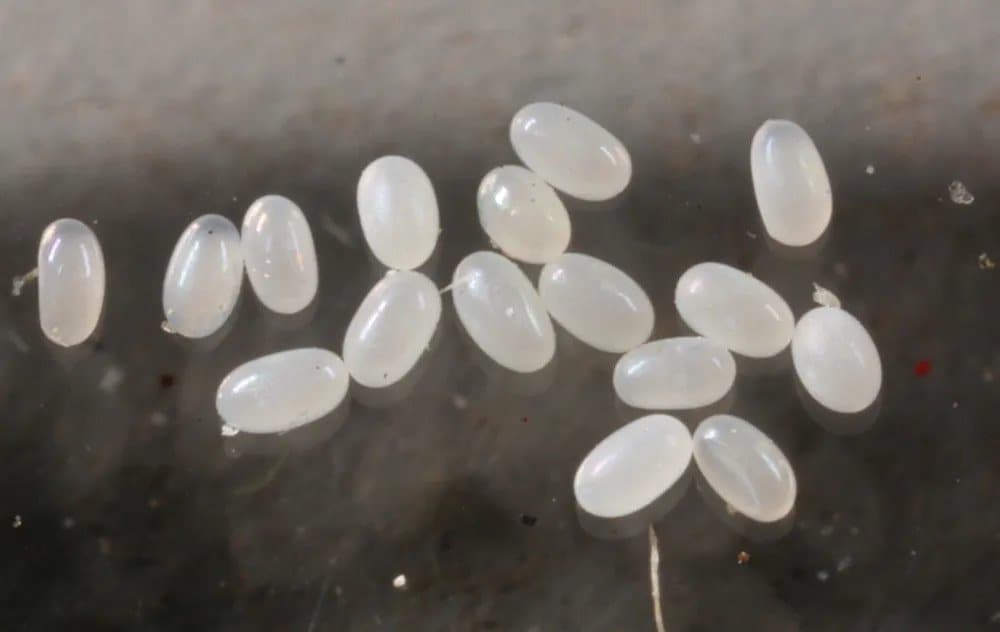
Fleas lay eggs on various surfaces, including furniture. Female fleas can lay up to 50 eggs per day, which usually fall off the host and disperse on carpets, bedding, and furniture where they can develop into larvae. Thus, it is crucial to treat not just the pets but also the environment when dealing with a flea infestation.
How can you confirm a flea infestation on furniture?
Confirming a flea infestation in furniture typically involves a combination of observation and physical investigation. Keep an eye out for signs like pets excessively scratching, tiny black specks (flea feces), and visible adult fleas jumping on the furniture or people. You can also use a flea comb on your pet and check the bristles for trapped fleas and flea dirt. Lastly, you can place a white cloth or paper towel under the furniture and then gently tap the upholstery to catch any falling flea dirt.
What are the signs of fleas in furniture such as couches and sofas?

The presence of fleas in furniture like couches and sofas can manifest as:
- Adult fleas jumping on and off the furniture
- Flea dirt or flea feces (small, black particles)
- Flea eggs (tiny, white-to-transparent ovals)
- Flea larvae or pupae (small, worm-like or cocoon-like creatures)
- Pets or humans with flea bites (small, red, itchy bumps)
What are the consequences of having fleas in furniture?

Fleas in furniture can lead to a range of problems, including:
- Discomfort and itching in humans and pets due to flea bites
- Flea allergy dermatitis (skin inflammation due to an allergic reaction to flea saliva) in pets
- Possible transmission of diseases, such as tapeworms, to pets
- Stress and anxiety for homeowners due to the infestation and persistent biting
- Potential damage to furniture and other household items by larvae feeding on organic debris and excrement
How to differentiate between fleas and other pests in furniture?
When dealing with pests in furniture, it’s crucial to correctly identify the type of pest to choose the appropriate treatment method. Here’s a comparative table to help differentiate between fleas and other common pests found in furniture, like bed bugs and ticks:
| Characteristics | Fleas | Bed Bugs | Ticks |
|---|---|---|---|
| Size | 1/16 to 1/8 inches (1.5 to 3.2 mm) | 1/5 inch (5 mm) | 3/16 to 1/2 inch (5 to 12 mm) |
| Shape | Thin, oval, laterally flattened | Broad, oval, and flattened | Oval, flat until engorged |
| Color | Reddish-brown | Reddish-brown to dark brown | Varies (brown, black, grey, etc.) |
| Jumping Ability | Can jump up to 13 inches horizontally | Cannot jump, but crawls quickly | Cannot jump; crawls |
| Common Signs | Flea dirt, bites, high activity | Rusty spots on bedding/furniture, bites | Attach to hosts, visible at larger size |
| Preferred Environment | Warm, humid places close to hosts | Mattress seams, furniture crevices | Tall grasses, shrubs, and areas with hosts |
The Basics of Treating Flea Infestations in Furniture
What are the initial steps to take in treating a flea infestation in furniture?

To treat a flea infestation in furniture, follow these initial steps:
- Identify the extent of the flea infestation: Inspect your furniture thoroughly for signs of fleas, eggs, and larvae.
- Clean and sanitize the area: Vacuum the furniture, rugs, and carpets, disposing of the vacuum bag afterward. Wash and sanitize pet bedding and any washable cushion covers or throw pillows.
- Treat your pets: Consult your veterinarian to choose the appropriate flea treatment products for your pets. Regularly groom your pets using flea combs to remove fleas and their eggs.
What are effective methods of removing fleas from furniture?

Treating flea infestations in furniture effectively requires a combination of techniques tailored to different stages of the flea’s life cycle. Below is a table outlining various methods, detailing how each contributes to eliminating fleas from your furniture:
| Method | Description | Steps Involved | Considerations |
|---|---|---|---|
| Vacuuming | Removes fleas, eggs, larvae, and pupae from furniture surfaces. | 1. Use high suction power. 2. Attach crevice tool for hard-to-reach areas. 3. Vacuum frequently. | Ensure to dispose of vacuum bags immediately to prevent re-infestation. |
| Chemical Treatments | Uses flea sprays, powders, or aerosols specifically designed for furniture. | 1. Apply according to manufacturer’s instructions. 2. Allow to dry. 3. Repeat as necessary. | Wear protective gear; keep pets and children away during application. |
| Steam Cleaning | Kills fleas and eggs on contact by using high heat and pressure. | 1. Steam clean thoroughly, covering all areas of the furniture. 2. Repeat periodically. | Avoid on delicate fabrics that may be damaged by high heat. |
How do flea sprays and powders work, and how to choose the right one for furniture?

Flea sprays and powders contain insecticides that target fleas in different life stages. They work by disabling the flea’s nervous system, ultimately causing death. Some products also contain insect growth regulators (IGRs), which stop eggs and larvae from developing into adult fleas.
To choose the right flea spray or powder for your furniture, consider the following:
- Opt for products labeled safe for use on furniture.
- Look for products with IGRs to prevent the growth of flea populations.
- Read and follow the manufacturer’s instructions to ensure proper application and effectiveness.
- Consider using a reputable brand or seeking professional recommendations.
What role does vacuuming play in getting rid of fleas in furniture?
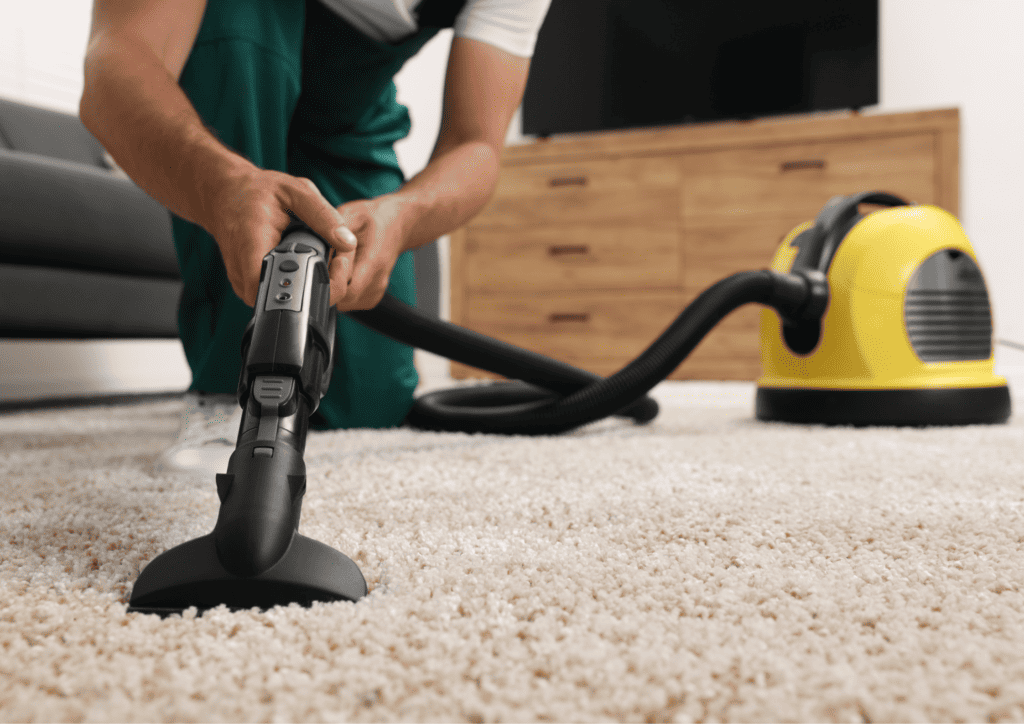
Vacuuming is an essential step in eliminating fleas from furniture. Vacuuming helps to:
- Remove fleas, eggs, larvae, and pupae from furniture surfaces
- Disrupt the flea’s life cycle by eliminating breeding grounds
- Remove debris and dirt, which can serve as a food source for flea larvae
For best results, use a vacuum with high suction power and attach a crevice tool for hard-to-reach areas. Empty and clean the vacuum’s canister or dispose of the vacuum bag after each use to prevent re-infestation. Repeat vacuuming frequently during the flea removal process.
Advanced Methods of Flea Removal from Furniture
How does steam cleaning contribute to flea removal in furniture?
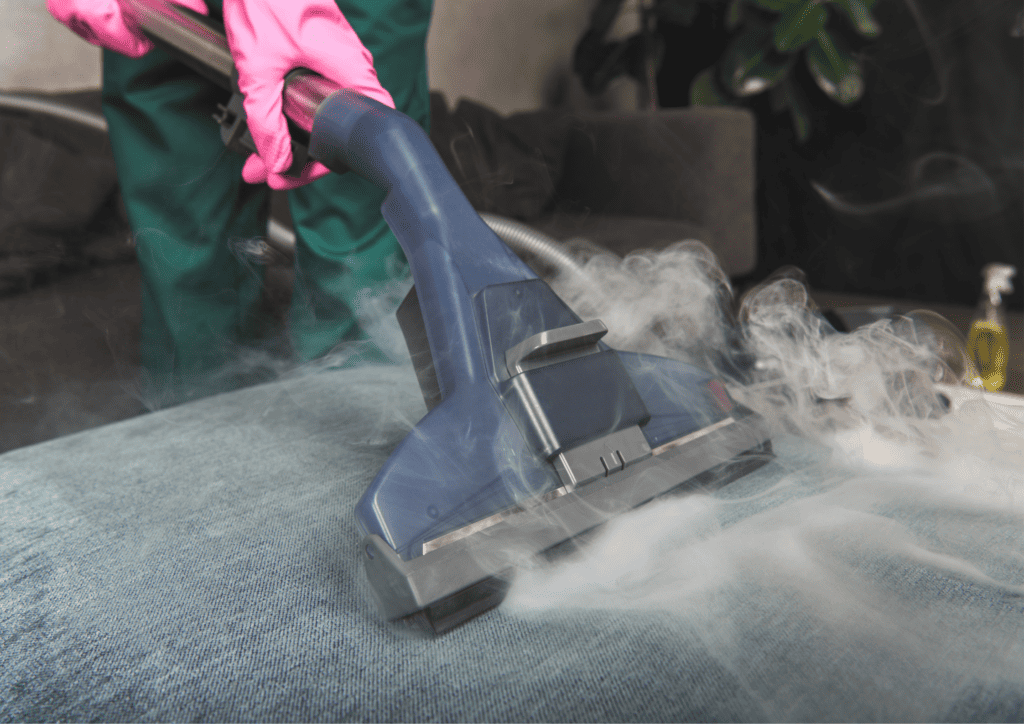
Steam cleaning can be highly effective at removing fleas from furniture due to the high heat and pressure involved in the process. High-temperature steam effectively kills fleas, eggs, and larvae on contact, making it an efficient, non-chemical option for treating furniture. Steam cleaners also help remove dirt, pet hair, and food debris, further reducing the chances of flea survival.
When and how to use flea bombs or foggers for furniture?

Flea bombs or foggers are best used when dealing with a severe flea infestation that cannot be managed with regular cleaning and spot treatments. Flea bombs release insecticides into the air, which then settle on surfaces and furniture, killing fleas in the process.
To use a flea bomb effectively:
- Remove all people and pets from your home.
- Cover or remove any food, dishes, or kitchenware.
- Turn off any ignition sources, like pilot lights on gas appliances.
- Seal off aquariums and cover air pumps.
- Follow the product’s instructions carefully for the recommended application and ventilation times.
- After the designated time, ventilate your home for several hours before re-entry.
- Vacuum and clean all surfaces thoroughly once the fog has dissipated.
- Keep in mind that flea bombs are not a one-time solution. Regular cleaning and preventative measures are still necessary to maintain a flea-free environment.
How to treat removable covers and cushions from furniture to eliminate fleas?

To treat removable covers and cushions from furniture:
- Wash them in hot water (above 130°F) and detergent, as this temperature will kill fleas, larvae, and eggs.
- Use a dryer on a high-heat setting, if possible, to further ensure the elimination of fleas.
- If the covers are not machine-washable, consider steam cleaning or using a flea spray specifically designed for fabrics, following the manufacturer’s instructions.
How to get fleas out of a couch?
To remove fleas from a couch, follow these steps:
- Vacuum the entire couch thoroughly, including the cushions, seams, and any crevices.
- Apply a flea spray or powder treatment specifically designed for furniture, following the manufacturer’s directions.
- If possible, steam clean the couch to kill fleas, eggs, and larvae with high heat.
- Treat the surrounding area by vacuuming carpets, rugs, and floors, as well as washing or treating any removable cushion covers.
- Reapply flea treatments and vacuum frequently during the flea removal process to ensure complete eradication.
Effective Home Treatments for Furniture Flea Infestations
How to choose and apply flea treatment for furniture?
To choose and apply flea treatment for furniture:
- Search for products specifically designed for use on furniture, ensuring they’re safe for upholstered surfaces.
- Opt for flea sprays, powders, or aerosols containing insect growth regulators (IGRs) to disrupt the flea life cycle.
- Follow the manufacturer’s instructions for proper application, and wear gloves and a mask during the process.
- Keep children and pets away from treated areas until the product dries or as directed.
What home remedies can be effective in getting rid of fleas on furniture?
Home treatments can be a valuable first line of defense against flea infestations in furniture, offering natural and readily available solutions. Here’s a table that outlines some effective home remedies, their methods of application, and key considerations for each:
| Home Remedy | Method of Application | Effectiveness | Considerations |
|---|---|---|---|
| Dish soap Trap | Fill a shallow dish with warm water and a few drops of dish soap; place near infested furniture under a light source at night. | Moderate; attracts and traps adult fleas. | Safe for use around pets and children; needs to be reset regularly. |
| Diatomaceous earth | Sprinkle food-grade diatomaceous earth on and around the furniture; vacuum after 24-48 hours. | High; dehydrates and kills fleas. | Wear a mask to avoid inhalation; ensure it’s food-grade for safety. |
Please note that home remedies should not replace professional pest control methods for significant infestations.
How to use flea sprays specifically designed for couches and sofas?

To use flea sprays designed for couches and sofas:
- Test the spray on a small, inconspicuous area of the fabric first to check for any potential staining or damage.
- Follow the manufacturer’s instructions for application, spraying the product evenly on the entire couch or sofa, including cushions, seams, and other hiding spots.
- Allow the product to dry completely before using the furniture again.
- Keep children and pets away from the treated area until it is safe to return.
How to get rid of flea eggs on furniture?
To get rid of flea eggs on furniture:
- Vacuum the furniture thoroughly to remove as many eggs as possible.
- Apply a flea treatment containing an insect growth regulator (IGR) to stop eggs from developing into adult fleas.
- Steam clean the furniture to kill any remaining eggs with high heat.
- Wash removable covers and cushion casings in hot water to eliminate eggs.
Preventing Flea Re-infestations in Furniture
How to prevent future flea infestations on furniture?

Preventing flea re-infestations in furniture is crucial for maintaining a comfortable and healthy home environment. Below is a table that outlines various preventive measures, their frequency, and specific methods to ensure your furniture stays flea-free:
| Preventive Measure | Frequency | Specific Method |
|---|---|---|
| Regular Pet Grooming | Daily to weekly | Use flea combs to remove fleas and eggs; regularly bathe pets with flea-preventive shampoo. |
| Vacuum Furniture and Floors | Weekly | Focus on areas frequented by pets and hard-to-reach spots in furniture; dispose of bags promptly. |
| Wash Pet Bedding and Cushion Covers | Weekly to monthly | Wash in hot water to kill fleas and eggs; dry on high heat for extra effectiveness. |
| Flea Preventive Treatments | As recommended | Apply topical or oral flea control products to pets as advised by a veterinarian. |
| Inspect Furniture Regularly | Monthly | Check for signs of flea activity; use a white cloth to catch flea dirt as a detection method. |
What are the preventive flea treatments available for furniture?
Preventive flea treatments for furniture include:
- Insect growth regulators (IGRs) in the form of sprays or powders.
- Long-lasting, furniture-safe flea sprays designed to prevent infestations.
- Regular steam cleaning to eliminate potential eggs and larvae.
- Regular application of diatomaceous earth in and around furniture.
What to do to ensure fleas do not return to your furniture?

To ensure fleas do not return to your furniture:
- Implement a consistent flea prevention plan for your pets, including regular grooming and veterinarian-approved treatments.
- Maintain a clean home environment by frequently vacuuming and washing pet bedding, cushion covers, and rugs.
- Apply preventive flea treatments as needed to your furniture.
- Inspect your furniture periodically for signs of flea activity.
How can regular cleaning prevent fleas in furniture?

Regular cleaning helps prevent fleas in furniture by:
- Removing flea eggs, larvae, and adult fleas before they can establish themselves and reproduce.
- Eliminating debris, pet hair, and food particles that can serve as food for flea larvae.
- Keeping the furniture and home environment less hospitable for fleas to thrive.
What ongoing maintenance and cleaning methods can prevent fleas from residing in furniture?
Ongoing maintenance and cleaning methods include:
- Regular vacuuming of furniture, floors, carpets, and pet bedding.
- Washing removable cushion covers and pet bedding in hot water.
- Steam cleaning furniture periodically to kill any existing fleas and their eggs.
- Using preventive flea treatments and monitoring your pets for signs of flea activity.
Conclusion: The Importance of Keeping Furniture Flea-Free
What are the health implications of allowing fleas to live in furniture?
Allowing fleas to live in furniture can lead to health issues, such as:
- Skin irritations and allergic reactions from flea bites in both humans and pets.
- Flea allergy dermatitis in pets, leading to severe skin inflammation and infection.
- The potential transmission of diseases and parasites, like tapeworms, to pets.
How does maintaining a flea-free environment contribute to a healthier home?

Maintaining a flea-free environment contributes to a healthier home by:
- Preventing the discomfort and health issues associated with flea bites and infestations.
- Ensuring a clean and hygienic living space for both humans and pets.
- Reducing the stress and anxiety caused by a flea-infested home.
- Protecting your furniture and other household items from damage caused by flea larvae feeding on organic material.
Eliminating and preventing fleas in your furniture is vital to create a comfortable and healthy living environment. By following the suggested methods, home remedies, and preventative measures, you can enjoy a flea-free home and protect your family and pets from these pesky invaders.

